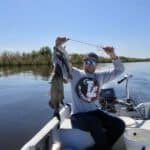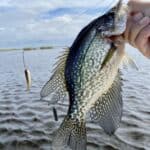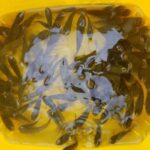Imagine this: You are excited for a fun day of fishing on the lake…but when you arrive at the bait shop there is a sign on the door that says “Sold out of minnows“.
You think, no worry, I’ll just catch my own at the lake…only to waste hours trying to catch bait with nothing to show for it…frustrating!
Well, every angler has faced this scenario at one time or another…especially during peak season.
The solution? Raising minnows for bait from the comfort of your home.
In this guide, ill tell you everything you need to know so you can be sure you have a steady supply of minnows for fishing.
This page contains affiliate links. As an Amazon Associate, I earn from qualifying purchases.
Table of Contents
Can You Raise Minnows at Home?
Raising minnows at home can be a fun and rewarding process that leads to huge savings on bait costs for anglers. Depending on the scale of the operation, minnows can be raised anywhere from a small studio apartment to a massive backyard pond!
How To Get Started
Raising minnows for bait is a relatively simple process. Below are four simple steps to begin your journey.
- Research
- Gather all equipment (checklist below)
- Decide on the proper species of minnow
- Acquire Minnows from bait shops, hatcheries, or the wild.
The first step is doing a bit of research. You should first consider what kind of minnows will work best as bait in your most visited fishing spots.
You should then do a deep dive into what the fish in your local area are feeding on. You can start by asking around at bait shops, and lean on personal experience.
Think about where you will be using your baitfish most often, and which size and species of minnow will be best for you.
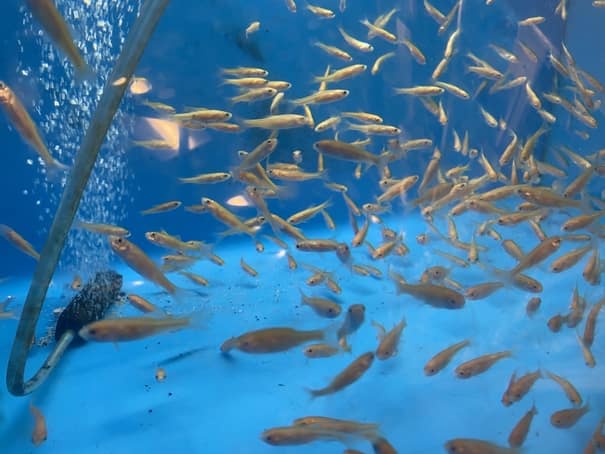
Fathead minnows are the most popular options for smaller bait, while common shiners and emerald shiners are the most popular larger baitfish.
The Fathead minnow is the most common type of minnow raised by anglers for bait.
They are easy to procure, as well as raise as they are adaptable to a wide variety of water qualities and temperatures. These are the best baitfish for anglers who fish for average-sized freshwater fish.
For anglers who prefer to chase monsters on the lake, shiners can also be raised as baitfish.
While they will reproduce more slowly than fathead minnows, they will grow to about double the size and are better bait options for targeting larger predatory fish like largemouth bass. Shiners also cost much more, so the savings can be significant.
Once you have chosen the correct species of minnow to raise, there are a few different options for purchasing your fish.
Local bait shops can be a bit pricey, but they will generally have a good crop of healthy minnows for sale that are appropriate for fishing local waters and are also helpful with tips.
If you live within driving distance of a fish hatchery, this can be the best option for saving a bit of money. Hatcheries are larger-scale operations than bait shops and will offer a lower price on common minnow species, as well as offering bulk discounts.
For these reasons, hatcheries are best for larger operations.
If you do not have a bait shop or fish hatchery nearby, you can catch your own minnows in the wild. This is the preferred method if you really want to focus on the native baitfish in your area (just be sure to check regulations!).
Buy Live Minnows Online
And last but not least…did you know you can actually buy live minnows online from Amazon?

Ordering live minnows and bait from Amazon seems crazy…but these are highly regulated and sold by professional fish hatcheries.
You can find everything from live fathead minnows, to golden shiners and even live mosquitofish.
If I know I won’t have time to catch bait, I’ll order a couple of dozen minnows ahead of time. They have saved me from a bad weekend of fishing many times!
What Equipment Is Needed?
To get started raising minnows you will need at least one tank or receptacle, preferably two or more. You will also need an aerator to keep the water oxygenated, as well as an underwater structure for the females to release their eggs under. You will also need a small net for removing fish, and a clean source of water.
- Tank
- One gallon of water for every inch of minnow to be kept
- Example – 50 x 1 inch minnows = 50 gallon tank
- Water
- Do not use tap or chlorinated water
- Natural spring water and distilled water are good options
- Aerator
- Electric aerators are very affordable
- Can be purchased online or at pet shops
- Structure
- Females will lay eggs under structure to keep them from floating up
- Clay pots and decorative fish tank accessories work well for this
- Feed
- Feed for minnows can either be store-bought flakes or naturally sourced
- Baby minnows should be fed a slightly different diet (covered below)
Is a Tank or Pond Better?
Fish tanks are the best option for raising minnows, especially for first-timers, and those setting up a new operation. Having multiple tanks allows you to separate babies from adults, as well as separate and introduce males and females for mating.
It is also much easier to maintain and control the water quality and overall environment compared to a pond, as you are in control of every factor.
Tanks also make it easier to relocate fish when the population becomes too dense, helping to avoid overcrowding.
Another option, if you have the space is a plastic feed tank:

These durable tanks are usually made of recycled materials and can be used indoors or outdoors.
They’re also really easy to customize (with aeration systems, covers, and added structure, etc.).
How Many Minnows per Tank/Pond?
While the ideal population density for keeping minnows will vary slightly based on species and water temperature, the general rule among anglers is one gallon of water for every one inch of fish you have. Many anglers will keep more than this amount, but this is a safe estimate.
| Minnows | 100 Gallons | 200 Gallons | 300 Gallons | 400 Gallons |
| 1 Inch Minnows | 100 | 200 | 300 | 400 |
| 2 Inch Minnows | 50 | 100 | 150 | 200 |
| 3 Inch Minnows | 33 | 66 | 100 | 133 |
| 4 Inch Minnows | 25 | 50 | 75 | 100 |
How Fast Do Minnows Reproduce?
Fathead minnows reproduce very quickly and will spawn every three to six days once they are settled into the environment and introduced to the opposite sex. The female can lay between 100 and 400 eggs at a time depending on size. Larger minnows like shiners will take multiple weeks between spawning.
It is important to stay vigilant with tracking and maintaining the density of minnows once they start reproducing.
Babies should be separated into a different tank, and minnows should be removed when necessary to maintain the one gallon of water per inch of fish guideline.
What To Feed Minnows?
Pet supply stores offer a variety of nutrient-dense dehydrated flakes and powders that will give your minnows everything they need to grow and stay healthy. The most popular over-the-counter options are brine shrimp flakes, as well as fish food intended for goldfish and tropical fish species.
Some anglers prefer to procure their own feed for their minnows, either to save money or to provide the fish with certain specific nutrients.
Microworms and powdered spirulina are fantastic options to boost the health of minnows, and decomposing leafy plants have also been fed to fatheads with great success.
Is Breeding Minnows Easy?
Once the tank is set up with the proper water type and temperature, the aerator is installed, and structure is added for the minnows, the actual upkeep and breeding processes are fairly easy. The most common method is to separate the sexes until they are acclimated to the tanks, then combine them and wait!
Another common tactic is to use a larger tank for breeding and combining that is large enough to give the minnows extra space. This larger breeding tank should also be equipped with plenty of structure for females to spawn.
Many anglers have also found it helpful to raise the water temperature by five degrees during breeding.
While it is not necessary to maintain the tank’s temperature in many instances, small water heaters, fan coolers, and thermometers can help maintain an ideal environment for your minnows.
Why Do People Fail at Raising Minnows?
The most common reason that people fail when raising minnows for the first time is not maintaining or procuring the proper quality of water. Only natural spring or distilled water should be used, and the minnows should be allowed to acclimate to the new tank temperature before being transferred.
Overcrowding is also another huge problem, as many anglers find it hard to keep up with the constant reproduction of the minnows once everything is set up.
Maintaining one gallon of water per inch of minnow is important to maintain the proper density of fish.
You May Also Like: How To Keep Minnows Alive Without an Aerator (7 Tips)
Final Thoughts
If you are thinking of raising or growing your own minnows for fishing…don’t get overwhelmed or start too big.
If you only have a bucket and an aerator…give it a try! That’s enough to raise a couple of dozen minnows and you will learn a lot. Next, upgrade to a 10, or 25-gallon tank, etc.
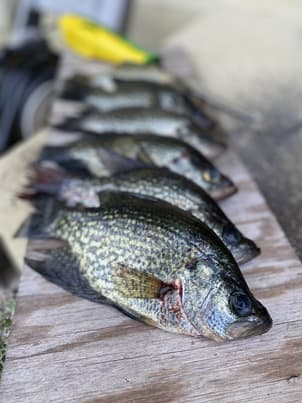
Before long, the entire neighborhood will be knocking on your door to get minnows, ha!
And who knows, maybe one day you can raise your own minnows to sell for profit?
Good luck!
See Also: How Many Minnows are in a Pound/Gallon/Scoop?
If you haven’t guessed yet, I love fishing and everything about it!
To learn more about why I started Panfish Nation, visit the About page and follow along on Social Media:


Download a copy of my FREE Lure Color Selection Chart & Knot Guide!
Stay up to date with fishing reports, tackle reviews, industry news, and much more! We respect your privacy, unsubscribe at any time.
Related Posts
Like this post? Save it on Pinterest.


